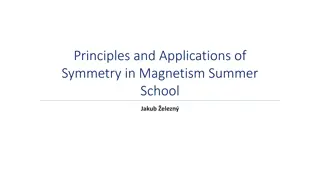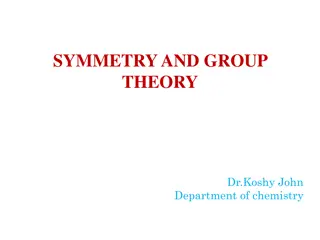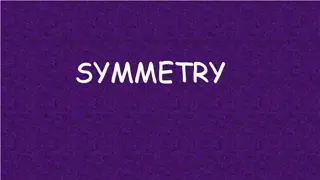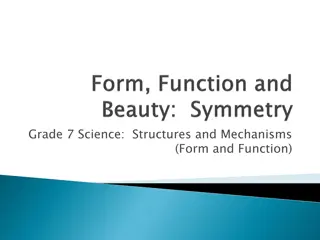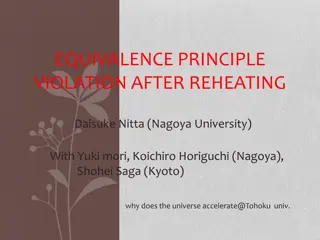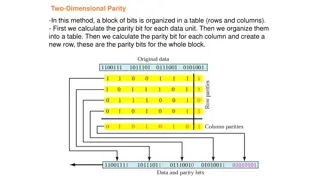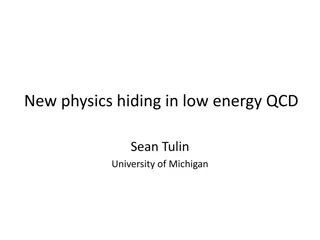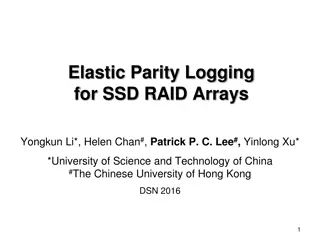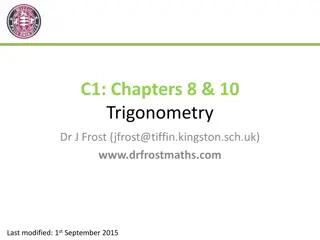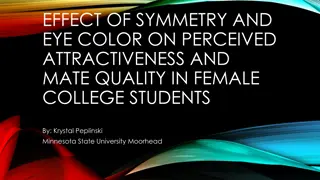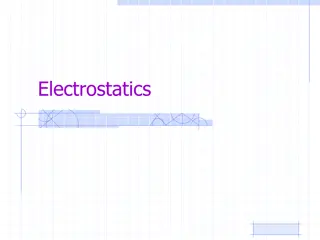Understanding Conservation Laws: Charge Conjugation, Parity Symmetry, and Violation
In this comprehensive guide, we delve into the intricate concepts of charge conjugation symmetry, G-parity, and the conservation and violation of parity symmetry in fundamental physics. Explore how these principles apply to strong, electromagnetic, and weak interactions through detailed explanations and insightful experimental investigations, such as the Wu experiment with cobalt-60 decay. Unravel the complexity of particle reactions and symmetries that govern the behavior of matter and antimatter in the universe.
Download Presentation

Please find below an Image/Link to download the presentation.
The content on the website is provided AS IS for your information and personal use only. It may not be sold, licensed, or shared on other websites without obtaining consent from the author. Download presentation by click this link. If you encounter any issues during the download, it is possible that the publisher has removed the file from their server.
E N D
Presentation Transcript
CONSERVATION LAWS (CONTINUED) :
So, its the content of this video we will be trying to understand in more detail in this second part of conservation laws: So here it is watch it carefully: https://youtu.be/yArprk0q9eE
Charge conjugation symmetry and its conservation (C) : According to this symmetry principle, when the sign of the charge of all the particles in a allowed process is reversed ( i.e. converting particles into anti-particles and vice-versa ) the resulting anti particle reaction is also equally allowed. EX: n ----- p + e- + e (allowed) then the reaction, n ------- p + e+ + e is also equally allowed. Similarly if you take any allowed reaction and replace all the particles in the process by anti particles and vice versa, the resulting reaction is also equally allowed. Charge conjugation symmetry is applicable to strong and electromagnetic interactions only. For weak interactions it fails. A combination of C- symmetry with isospin is called G-parity which is conserved only in strong interactions.
Parity symmetry; Conservation and violation: Parity is essentially reflection of space coordinates around the origin. That is, P (x,y,z)------- (-x,-y,-z) {reflection in space}. Let the parity operator be represented by UP then, UP* (UP )*T = (UP )*T * UP = I, where (UP )*T represents UP dagger (Hermitian conjugate). Therefore, ?? Now, UP (r) = p (r) UP (UP ) (r) = UP p (r) {from 1} UP (UP ) (r) = p UP (r) {re-arranging RHS}(3) UP (UP ) (r) = p2 (r) {from 1} from (4) we have p2 =1 p =+1 or -1 Therefore, from (1) we have, UP (r) = + (r) represents even parity. UP (r) = - (r) represents odd parity. Parity symmetry is conserved both in strong and EM interactions and is violated in processes involving weak interaction like -decay, decay of muons, kaons etc.., 2= 1 since UP is unitary and UP = (UP)*T , since UP is Hermitian. (1) (2) (4) https://youtu.be/Ukop9e8dAuI https://youtu.be/Ukop9e8dAuI https://youtu.be/BSTRJjElDdI https://youtu.be/wvnWCY9TKgw https://youtu.be/BSTRJjElDdI https://youtu.be/wvnWCY9TKgw
Violation of parity symmetry: Parity symmetry is experimentally observed to be violated in processes involving weak interaction like - decay, decay of muons, kaons etc.., Here is the better explanation of it I have found till date: watch it and understand it carefully: https://youtu.be/v44jEXN4sSY
The experiment: The experiment monitored the decay of cobalt-60( 60Co) atoms that were aligned by a uniform magnetic field (the polarizing field) and cooled to near absolute zero so that thermal motions did not ruin the alignment. Cobalt-60 is an unstable isotope of cobalt that decays by beta decay to the stable isotope nickel-60 ( 60Ni). During this decay, one of the neutrons in the cobalt-60 nucleus decays to a proton by emitting an electron (e-) and an electron antineutrino ( e). The resulting nickel nucleus, however, is in an excited state and promptly decays to its ground state by emitting two gamma rays ( ). Hence the overall nuclear equation of the reaction is: Gamma rays are photons, and their release from the nickel-60 nucleus is an electromagnetic (EM) process. This is important because EM was known to respect parity conservation, and therefore they would be emitted roughly equally in all directions (they would be distributed roughly "isotropically"). Hence, the distribution of the emitted electrons could be compared to the distribution of the emitted gamma rays in order to compare whether they too were being emitted isotropically. In other words, the distribution of the gamma rays acted as a control for the distribution of the emitted electrons. Another benefit of the emitted gamma rays was that it was known that the degree to which they were not distributed perfectly equally in all directions (the "anisotropy" of their distribution) could be used to determine how well the cobalt-60 nuclei had been aligned (how well their spins were aligned). If the cobalt-60 nuclei were not aligned at all, then no matter how the electron emission was truly distributed it would not be detected by the experiment. This is because an unaligned sample of nuclei could be expected to be orientated randomly, and thus the electron emissions would be random and the experiment would detect equal numbers of electron emissions in all directions, even if they were being emitted from each individual nucleus in only one direction. 60Co27 ----------- 60Ni28 + e- + e + 2
The experiment then essentially counted the rate of emission for gamma rays and electrons in two distinct directions and compared their values. This rate was measured over time and with the polarizing field orientated in opposite directions. If the counting rates for the electrons did not differ significantly from those of the gamma rays, then there would have been evidence to suggest that parity was indeed conserved by the weak interaction. If, however, the counting rates were significantly different, then there would be strong evidence that the weak interaction does indeed violate parity conservation. The experimental challenge in this experiment was to obtain the highest possible polarization of the60Co nuclei. Due to the very small magnetic moments of the nuclei as compared to electrons, high magnetic fields were required at extremely low temperatures, far lower than could be achieved by liquid helium cooling alone. The low temperatures were achieved using the method of adiabatic demagnetization. Radioactive cobalt was deposited as a thin surface layer on a crystal of cerium-magnesium nitrate, a paramagnetic salt with a highly anisotropic Land g-factor. The salt was magnetized along the axis of high g-factor, and the temperature was lowered to 1.2 K by pumping the helium to low pressure. Shutting off the horizontal magnetic field resulted in the temperature decreasing to about 0.003 K. The horizontal magnet was opened up, allowing room for a vertical solenoid to be introduced and switched on to align the cobalt nuclei either upwards or downwards. Only a negligible increase in temperature was caused by the solenoid magnetic field, since the magnetic field orientation of the solenoid was in the direction of low g-factor. The production of gamma rays was monitored using equatorial and polar counters as a measure of the polarization. Gamma ray polarization was continuously monitored over the next quarter-hour as the crystal warmed up and anisotropy was lost. Likewise, beta-ray emissions were continuously monitored during this warming period.[1]
Results and conclusions: In the experiment carried out by Wu, the gamma ray anisotropy was approximately 0.6.That is, approximately 60% of the gamma rays were emitted in one direction, whereas 40% were emitted in the other. If parity were conserved in beta decay, the emitted electrons would have had no preferred direction of decay relative to the nuclear spin, and the asymmetry in emission direction would have been close to the value for the gamma rays. However, Wu observed that the electrons were emitted in a direction preferentially opposite to that of the gamma rays with an asymmetry significantly greater than the gamma ray anisotropy value. That is, most of the electrons favoured a very specific direction of decay, specifically opposite to that of the nuclear spin. The observed electron asymmetry also did not change sign when the polarizing field was reversed, meaning that the asymmetry was not being caused by remanence in the samples. It was later established that parity violation was in fact maximal.
CP symmetry : conservation and violation: CP-symmetry, often called just CP, is the product of two symmetries: C for charge conjugation, which transforms a particle into its antiparticle, and P for parity, which creates the mirror image of a physical system. The strong interaction and electromagnetic interaction seem to be invariant under the combined CP transformation operation, but this symmetry is slightly violated during certain types of weak decay. Historically, CP-symmetry was proposed to restore order after the discovery of parity violation in the 1950s. Simply speaking, charge conjugation is a symmetry between particles and antiparticles, and so CP-symmetry was proposed in 1957 by Lev Landau as the true symmetry between matter and antimatter. In other words, a process in which all particles are exchanged with their antiparticles was assumed to be equivalent to the mirror image of the original process.
Yes, Even CP symmetry is violated by weak interaction! Tau-theta puzzle(T- puzzle) :Direct evidence of Parity and CP violation: Initially two decay modes of charged strange mesons were observed: + ----------- + + 0 T+ ------------ + + - + + The intrinsic parity of a pion is P = 1, and parity is a multiplicative quantum number. Therefore, the two final states have different parity (P = +1 and P = 1, respectively). It was thought that the initial states should also have different parities, and hence be two distinct particles. However, with increasingly precise measurements, no difference was found between the masses and lifetimes of each, respectively, indicating that they are the same particle. This was known as the puzzle. It was resolved only by the discovery of parity violation in weak interactions. Since the mesons decay through weak interactions, parity is not conserved, and the two decays are actually decays of the same particle, now called the K+. Neutral Kaons and CP violation: Kaons are a group of four light strange mesons made up of a quark and an anti-quark structure (q ? ????). They are distinguished from other type of mesons by the presence of strange quark(s). They are: K- = (s ?), K+ = (u ?) , K0 = (d ?) and K0 = (s ? ).
Kaons are pseudo scalar in nature: That is they pick up a negative sign when acted upon by parity operator. i.e., P (KA) = -(KA) where P represents the parity operator and KA = (K+ , K- , K0 K0 ) Upon, charge conjugation; C(K+) = (K- ) and vice-versa. C (K0 ) = ( K0) and vice-versa. Kaons have no CP Eigen states!! So let us consider only neutral kaons and construct its CP Eigen states: K1 = 1 K2 = 1 Now observe; CP(K1) = (K1 ) and CP (K2) = -(K2) so now K1 and K2 forms CP Eigen states of neutral kaons. Observe from above that CP Eigen value of K1 is +1 and that of K2 is -1. Neutral kaons decay by weak interaction in two ways: 1. Two pion decay mode : K0 ---- 2 0 / + + - 2. Three pion decay mode : K0 ---- 3 0 / + + - + 0 Now pions have intrinsic CP Eigen value of -1; so two pion decay mode will have CP Eigen value of +1 and three pion mode will have CP Eigen value of -1. (Eigen values being multiplicative in nature). Therefore, from (3) and (4) we can re-write (4) as: K1 ---- 2 0 / + + - . And, (5) as : K2 ---- 3 0 / + + - + 0 . 2 [K0 - ( K0)] 2 [K0 + ( K0)] (1) (2) (3) (4) (5) (6) (7) Experimentally in terms of life time, two types of neutral kaons have been observed. they are: short lived one denoted by KS with life time of 0.9 10 10 s. long lived one denoted by KL with life time of 0.5 10 7 s.
Now the two pion decay mode is more likely to happen when compared to three pion decay mode. So it becomes logical to assign K1 with KS and K2 with KL . So now we can re-write (6) and (7) as: K1 (KS ) ---- 2 0 / + + - . K2 (KL) --- 3 0 / + + - + 0 . (8) (9) In 1964: Christensen, Cronin, Fitch and others performed the following experiment: They let a neutral kaon beam propagate in a long tube with the other side having a detector, They got a pure KL beam reaching the detector but much to their surprise, they observed that KL decayed through two pion mode: that is, KL ---- 2 0 / + + - . The CP Eigen value on both sides of the EQ (10) did not match up. That is -1---- +1 (10) Expected Observed
Time Reversal symmetry(T) and CPT theorem: T-symmetry or time reversal symmetry is the theoretical symmetry of physical laws under the transformation of time reversal: T: t----- -t. That is laws of physics works same either forwards or backwards. Charge, parity, and time reversal symmetry (CPT Symmetry) is a fundamental symmetry of physical laws under the simultaneous transformations of charge conjugation (C), parity transformation(P), and time reversal(T). CPT is the only combination of C, P, and T that is observed to be an exact symmetry of nature at the fundamental level. Or in other words, the CPT theorem is a basic principle in particle physics which states that the combined operation of charge conjugation (C), time reversal (T), and parity (P) in any order is an exact symmetry of any interaction and that under the three transformations all physical laws must be invariant. Consequences and implications: The implication of CPT symmetry is that a "mirror-image" of our universe with all objects having their positions reflected through an arbitrary point (corresponding to a parity inversion), all momenta reversed (corresponding to a time inversion) and with all matter replaced by antimatter (corresponding to a charge inversion) would evolve under exactly our physical laws. The CPT transformation turns our universe into its "mirror image" and vice versa. CPT symmetry is recognized to be a fundamental property of physical laws. In order to preserve this symmetry, every violation of the combined symmetry of two of its components (such as CP) must have a corresponding violation in the third component (such as T); in fact, mathematically, these are the same thing. Thus violations in T symmetry are often referred to as CP violations.


